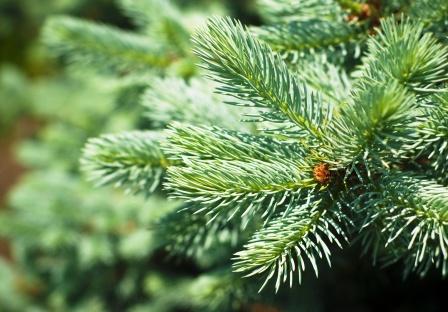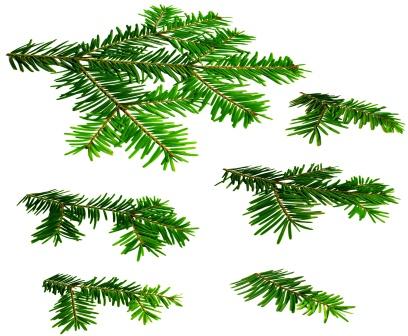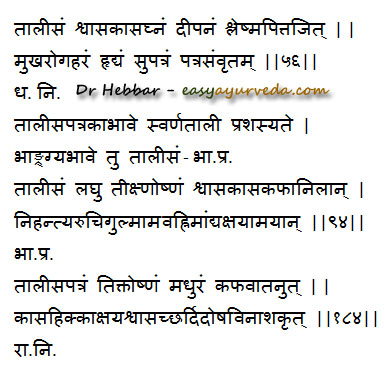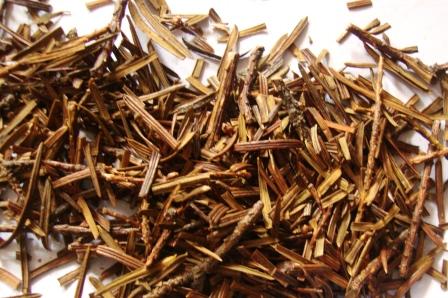Abies webbiana – Taleesa Patra Uses, Research, Side Effects
Talisa pathra – Abies webbiana is an ingredient in a famous Ayurvedic medicine for cough – Talisadi Choorna, used in treating cough and cold. It is aromatic, appetiser, expectorant and mildly laxative.
Botanical name- Abies webbiana Lindle / Abies spectabilis D.Don. Spach.
Family- PINACEAE (Devadaru Kula)

Table of Contents
Vernacular names
Names in different languages:
English Name- Indian Silver fir, Himalayan Silver fir
Hindi & Bengali Name- Talispatra
Telugu & Tamil Name- Talisapatri
Kashmiri Name- Budul
Sanskrit synonyms
Dhatri patra, Amalaki Patra – leaves resemble to those of Amla tree
Patradhya – Abundant leaves
Madhurapatra – leaves are sweet in taste
Sukodara, Dara, Arkavedha, Ghanacchada, Neelam, Neelambaram

Varieties
Abies pindrow Royle is quite similar to A. webbiana in benefits.
Yadavji trikamjit quotes that three herbs are taken in the name of Talisapatra –
1. Taxus baccata – Also identified as Sthauneyaka / Thunekara.
2. Abies webbiana and
3. Rhododendron lepidotum.
Abies webbiana is more commonly used in the name of Taleesapathra.
Distribution
Found in Himalayas from Kashmirto Assam at 1600-4500 m
Major chemical constituents- Abiesin, N- triacontanol, B- sitosterol, Betuloside, abioflavonoid etc. abietane, betuloside.
(Reference: Illustrated Dravyaguna VIjnana, Vol. II, by Dr JLN Shastry)
Morphology
Habit- A small or medium sized evergreen tree.
Stem-Fluted
Branches- Horizontal, wide spreading, not whorled
Leaves – linear, flattened, distichous, acute, narrowed into a short petiole which is decurrent along the twig, dark green and shining above, pale yellowish brown or rusty red below.
Inflorescence- Male inflorescence is Catkin, female is with solitary flower.
Flowers- Male flowers sub globose
Female flowers resembling leaf buds, each consisting of a few imbricate scales which are surrounded at the base by a membranous cap shaped disk.
Fruit-In fruit the disk enlarges, becomes succulent and bright red and surrounds the olive green seed of which only the tip is exposed.
| ReplyForward |
Medicinal qualities
Abies webbiana medicinal qualities:
Rasa (taste) – Tikta (bitter), Madhura (sweet)
Guna (qualities) – Laghu (lightness), Teekshna (strong, penetrating, piercing)
Vipaka- Katu – Undergoes pungent taste conversion after digestion.
Veerya – Ushna – Hot potency.
Effect on Tridosha – Kapha Vata Hara.
Pharmacological Actions – Antispasmodic, Emmenagogue, Antipyretic, Expectorant, Stomachic, Anti bacterial, Anti inflammatory
Part used, dosage
Part used: leaves
Dose: powder 2-5 g, in divided doses per day.
Sanskrit verse

Abies webbiana uses
Shwasahara – useful in treatment of asthma and chronic respiratory disorders.
Kasahara – useful in cough and cold
Deepana – improves digestion strength
Mukharogahara – useful in oral disorders
Hrudya – acts as cardiac tonic, congenial for heart
Aruchihara – useful in relieving anorexia
Gulmahara – useful in abdominal tumors
Amahara – Relieves ama – a product of indigestion and altered metabolism.
Agnimandyahara – Relieves indigestion, low digestion strength
Kshayahara – useful in chronic respiratory disorders, tuberculosis
Chardihara – relieves vomiting
Because of its expectoration and antitussive (anti cough) effect, it is used as ingredient in many Ayurvedic cough syrups such as Cofavin Syrup and Dekopfcyn cough syrup
How to take it?
Its leaves are dried under sunshade, ground into fine powder. It is administered along with honey or warm water in a dose of 250 mg – 2 grams, once or twice a day, as directed by an Ayurvedic doctor.
External application
Its paste is made with water and applied over the forehead to relieve headache.

Substitute
In case of unavailability, Bhava Prakasha mentions to use an herb called Swarna Tali.
In case of unavailability of Bharngi – Clerodendron serratum, Taleesa patra can be used as substitute.
Research
Side effects
If used in higher than the prescribed dose, it may cause stomach irritation.
It can be safely used in children and during lactation. Consult your doctor for its usage during pregnancy.
Interaction with medicines, supplements
Can this be used while taking Homeopathic medicine?
Yes. This product does not react with homeopathic medicine.
Can this medicine be continued while taking supplements like multivitamin tablets, Omega 3 fatty acids etc?
Yes. Generally, this product goes well with most dietary supplements. However, if you are taking more than one product per day, please consult your doctor for an opinion.
With western
medicines
Seek your
doctor’s advice if you are taking this product along with other western
(allopathic / modern) medicines. Some Ayurvedic herbs can interact with modern
medicine.
If both Ayurvedic and allopathic medicines are advised together, then it is
best to take Allopathic medicine first, wait for 30 minutes and then take the
Ayurvedic medicine.
Ayurvedic medicines
Ayurvedic medicines with Talisa patra –
Puga Khanda – used in the treatment of vomiting, gastritis, dizziness, abdominal pain etc.
Vyoshadi Vatakam – used for cold, cough and such other respiratory diseases.
Lavan Bhaskar Churan – used in the treatment of bloating, gas problem, spleen diseases, haemorrhoids etc.
Sthanika karma (Systemic Acton)
Externally – Reduce pain, indicated in headache for external application.
Internally
Nervous system – Indicated in Osteoarthritis, Rheumatic joint disease, sciatica, headache etc.
Digestive system – carminative, digestive, promote taste, facilitate proper movement of vata dosha. Indicated in loss of appetite, bloating, Anorexia, phantom tumor etc.
Respiratory System –Reduce excess kapha. Indicated in kasa (Cough) and Swasa, kshaya (Tuberculosis), Hoarseness of voice
Excretory system – Helps to increase urine production. Indicated in dysuria
Satmikarana – Promote body strength
Tapakrama – Indicated in fever of vata kapha origin. Also indicated in inflammation of the upper respiratory tract.











4 comments
Sai Hari
Doctor….
.Is Talisadi churna – 1/2 tea spoon with one spoon of Honey taken 2 times a day after food effective to fight SINUS infection .
Or is it only fore cough and common cold ???
I have head ache near the eyebrows because of SINUS. Will it help ????
Dr J V Hebbar MD(Ayu)Author
Hi, this also helps in sinus. But results may vary from person to person.
tanishqa
Very good article how much and how long can it given to child below 5 yrs for cough all the time, some times dry , some times wet , sometimes mix
how to take it and which company, we have dhootpapaeshwar and kerela companies
please let me know
Dr J V Hebbar MD(Ayu)Author
Hi, rather than taking Taleesa Patra alone, better to opt for Talisadi Churna – half a teaspoon along with honey, once in the morning, after food for a period of one month. After taking this, she can drink luke warm water. Any good Kerala company product is good enough.
If symptoms do not improve even after a week’s usage, please consult your doctor.
Read more about Talisadi Churna – http://ayurmedinfo.com/2012/04/13/talisadi-churna-benefits-dosage-ingredients-side-effects/